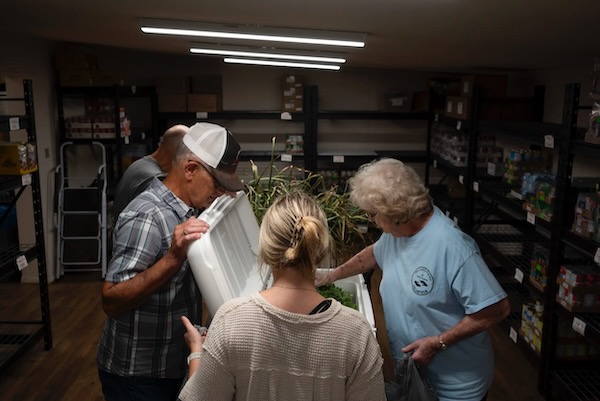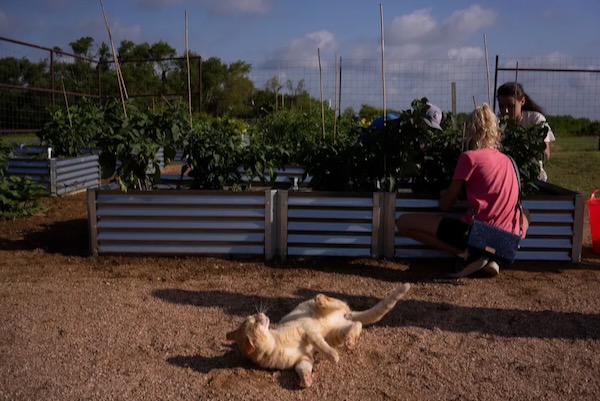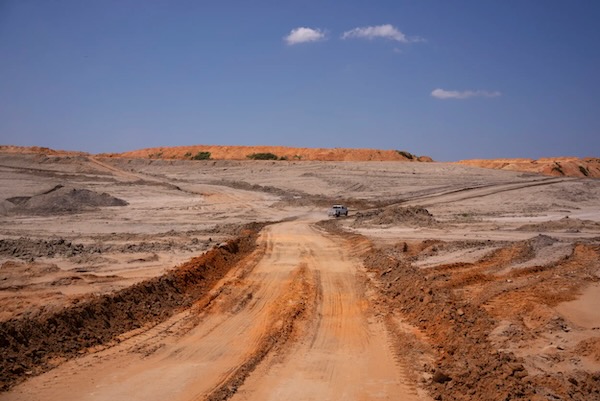
Volunteer gardeners, from left, Ava Moore, 18; Caleb Rappolee, 17; Pera Taylor, 11; and Salaya Henderson, 11, pick fresh onions at the Dewey Prairie Garden in Donie on June 29. The Dewey Prairie Garden is a pilot program by NRG as it continues the Jewett mine’s environmental reclamation. Photo by Joe Timmerman, The Texas Tribune.
July 21, 2023
By Alejandra Martinez, The Texas Tribune
Five homeschoolers pick fist-size garlic cloves, green jalapeсos, strawberries, squash and kale on a breezy Thursday morning in late June. They’re volunteering at a local food garden where bright orange marigolds attract bees from a local keeper’s hive.
The 1-acre garden has yielded about 10,000 pounds of produce for six food pantries since it began harvesting in April 2022. Texan by Nature, which manages the garden and was founded by former First Lady Laura Bush, estimates it has served approximately 2,000 people per month in Limestone, Freestone and Leon counties.
The garden in the middle of a 35,000-acre former mine is supplying thousands of pounds of fresh produce to families in three counties that have few grocery stores.
Located in Freestone County about 60 miles east of Waco, NRG Energy Dewey Prairie Garden is a part of a massive effort to restore a 35,000-acre lignite coal mine, which stretches mainly into the town of Jewett and used to fuel NRG’s Limestone Electric Generating Station, a 1,688-megawatt power plant. An NRG spokesperson said the coal plant began running on cleaner-burning coal from Wyoming in 2016.
That’s when the company halted mining locally after more than three decades.
 Volunteers prepare fresh vegetables donated by the Dewey Prairie Garden for distribution at the Lord’s Pantry of Leon County in Buffalo. Photo by Joe Timmerman, The Texas Tribune.
Volunteers prepare fresh vegetables donated by the Dewey Prairie Garden for distribution at the Lord’s Pantry of Leon County in Buffalo. Photo by Joe Timmerman, The Texas Tribune.
Debbie Glaze, a lead gardener for Texan by Nature, says it’s hard to imagine the garden was once a coal mine. The company has set aside 9 more acres to expand the garden, which was started as a pilot project.
“You wouldn’t think that this could happen,” Glaze said. “I think it is amazing that the ground is actually growing all these vegetables after all that mine digging.”
The Jewett mine’s manager, Michael Altavilla, said he hopes the garden can show how the industry can work with local communities for everybody's benefit.
“The mining industry has always been seen like we’re the bad guys, we’re destroying the Earth,” Altavilla said. “We want to take people out and show them this form of reclamation, a second purpose, not only mining the coal for energy, but utilizing the ground afterward.”
Company set aside $112 million to restore mine
Lignite was first mined in Texas during the 1850s and was produced primarily from underground mines, but declined in the early 1950s as the oil and gas industry grew in the state. Around the same time, companies began surface mining — which includes strip mining and open-pit mining — to provide fuel for power plants and the concrete industry.
The new mines harvested lignite coal, a form of soft coal that often lies close to the surface. Lignite mining led to bulldozing forests, burying streams, destroying wildlife habitat and leaving the ground contaminated with arsenic, lead and other toxins considered unsafe for human exposure after the mines closed.
 Dewey, the farm cat, cools off in the dirt while volunteer gardeners pick vegetables from the Dewey Prairie Garden in Donie. Photo by Joe Timmerman, The Texas Tribune.
Dewey, the farm cat, cools off in the dirt while volunteer gardeners pick vegetables from the Dewey Prairie Garden in Donie. Photo by Joe Timmerman, The Texas Tribune.
In 1975, the Texas Legislature authorized the Texas Railroad Commission, which oversees Texas’ oil and gas industry, to regulate surface coal mining. In 1977, the federal government created a fund to help pay for cleaning up old mines and required companies to restore the land to its prior condition after closing a mine.
As part of the federal law, a new agency, the Surface Mining and Reclamation Division, was given responsibility to enforce all the new regulations. The Railroad Commission began requiring companies mining coal in Texas to get a state permit and post a bond for each mining site they operate in the state to pay for restoration later.
But the agency has been criticized for allowing companies to do the bare minimum in cleaning up contaminated soil and water at mining sites and failing to enforce the law, according to a 2019 investigation by The Texas Tribune and Grist.
NRG has bonds totaling $112 million to restore the Jewett mine, a process that began in 1986, a year after mining began. Companies commonly do reclamation work even as they’re still mining a site. The reclamation process can take eight to 12 years.
So far, the company says it has replanted 3,500 acres with native grasses, is creating 700 acres of wetlands and has fully reclaimed 5,590 acres at the Jewett mine.
 A truck drives on a dirt road that winds through a section of the NRG Jewett Mine that is undergoing environmental reclamation. Photo by Joe Timmerman, The Texas Tribune.
A truck drives on a dirt road that winds through a section of the NRG Jewett Mine that is undergoing environmental reclamation. Photo by Joe Timmerman, The Texas Tribune.
MOVING DIRT AND REPLANTING OLD MINE PITS
About 8 miles from the garden at another end of the mine site, Joe Harris, a 56-year-old Jewett mine reclamation specialist, wears a reflective vest and a hardhat as he prepares to jump into his pickup truck to snap progress photos of the restoration work.
Harris drives up and down the slopes around mining pits to where the dragline, a massive excavator with a bucket, is working. There’s a clear divide in the ground, from the orange-brown dirt at the surface to the gray deposits down in the pits where coal was extracted. The 300-foot-tall excavator, with a bucket the size of a two-car garage, has the first and most crucial step in returning the land to its original form — refilling those holes.
Mark Payne, who’s been working at the mine for 37 years and operating the dragline for 17 years, wears denim on denim and black sunglasses as he operates the machine from an air-conditioned control room inside the machine’s body. Using levers that look like something from an old arcade game, Payne moves about 150 tons of dirt at a time as country music plays on the radio.
“We've been in this part of the mine trying to fill the hole in for almost a year. It takes quite a long while,” Payne said.
Once the pit is filled with soil, the company is required to plant grasses and vegetation similar to what’s growing nearby.
“During the springtime, we plant bermuda grass, in the summer millet and in the fall they plant rye grass,” Harris said.
Dragline operator Mark Payne excavates and moves tons of dirt at the mine, where he has worked for 37 years. “We’ve been here, in this part of the mine, just trying to fill this hole for almost a year,” Payne said. “It takes quite a long time.” Photo Joe Timmerman, The Texas Tribune
 Planning specialist Joe Harris explains the environmental reclamation process at the NRG Jewett Mine. Photo by Joe Timmerman, The Texas Tribune.
Planning specialist Joe Harris explains the environmental reclamation process at the NRG Jewett Mine. Photo by Joe Timmerman, The Texas Tribune.
Once the seeding is done, the company enters a five-year monitoring period during which the soil and water is regularly tested to check for toxic materials.
Inspectors from the Railroad Commission’s Surface Mining and Reclamation Division make monthly visits to mine sites to review test results and check that the company is following reclamation regulations.
The area that includes the garden was monitored for years, and the bond money was released back to the company in 2013, close to 10 years before the garden began harvesting produce. Recent soil reports submitted to the state show the soil is fertile with no toxic-forming materials present.
At another portion of the mine where seeding has already happened, enormous stretches of grasslands are marked by white PVC pipes that have defining stripes: A green stripe means it is under evaluation, while red stripes mean the site has been fully reclaimed.
Harris said the best part of working at the Jewett mine for the past three decades is seeing the land being restored after being here when it was initially scraped to harvest the coal.
“I’ve seen the mining, the clearing, to everything,” Harris said. “I take a lot of pride in this. We want it to look like it was never mined before so when I bring my grandchildren and great-grandchildren, I can say, ‘Look, there was once a mine here.’”
 Volunteers and employees at the Leon Community Food Pantry and Clothes Closet in Jewett work together to cart food to a client. Photo by Joe Timmerman, The Texas Tribune.
Volunteers and employees at the Leon Community Food Pantry and Clothes Closet in Jewett work together to cart food to a client. Photo by Joe Timmerman, The Texas Tribune.
GARDEN FEEDS LOCAL FAMILIES
About 16 miles from the mine, garden volunteers deliver zucchini, kale and other produce to a food pantry in Buffalo, a town of about 1,700 where residents have few grocery store options.
Amy Windham, a 37-year-old pantry client and single mother of three, says she always tries to be the first one here because she wants first dibs on the fresh-picked produce.
“Moving up here from Houston, it was such a culture shock because down [in Houston] there is a grocery store on every corner and here it’s only Brookshire [Brothers],” she said. “So that’s the one thing I appreciate about this pantry. The produce is better, you can tell.”
She grabs a cart, and Richard Dahlgrem, 80, a pantry volunteer, helps her pick out groceries. There’s a limit on how much each customer can take depending on the size of their household, but everything is free.
Dahlgrem said it’s nice to see resources from the old mine being poured back to help the community, especially those who are struggling to feed their families.
“What was brought in today is a good indication of what can come from people purposely doing something to help somebody,” he said.
Disclosure: NRG has been a financial supporter of The Texas Tribune, a nonprofit, nonpartisan news organization that is funded in part by donations from members, foundations and corporate sponsors. Financial supporters play no role in the Tribune's journalism.
Stay up to date on everything green in North Texas, including the latest news and events! Sign up for the weekly Green Source DFW Newsletter! Follow us on Facebook,Twitter and Instagram. Also check out our podcast The Texas Green Report, available on your favorite podcast app.









